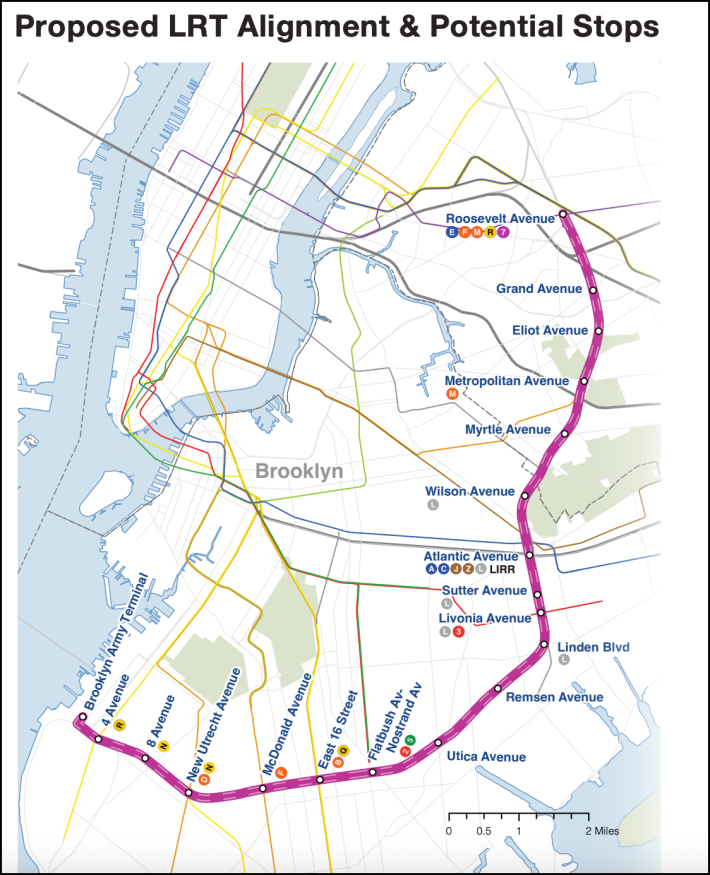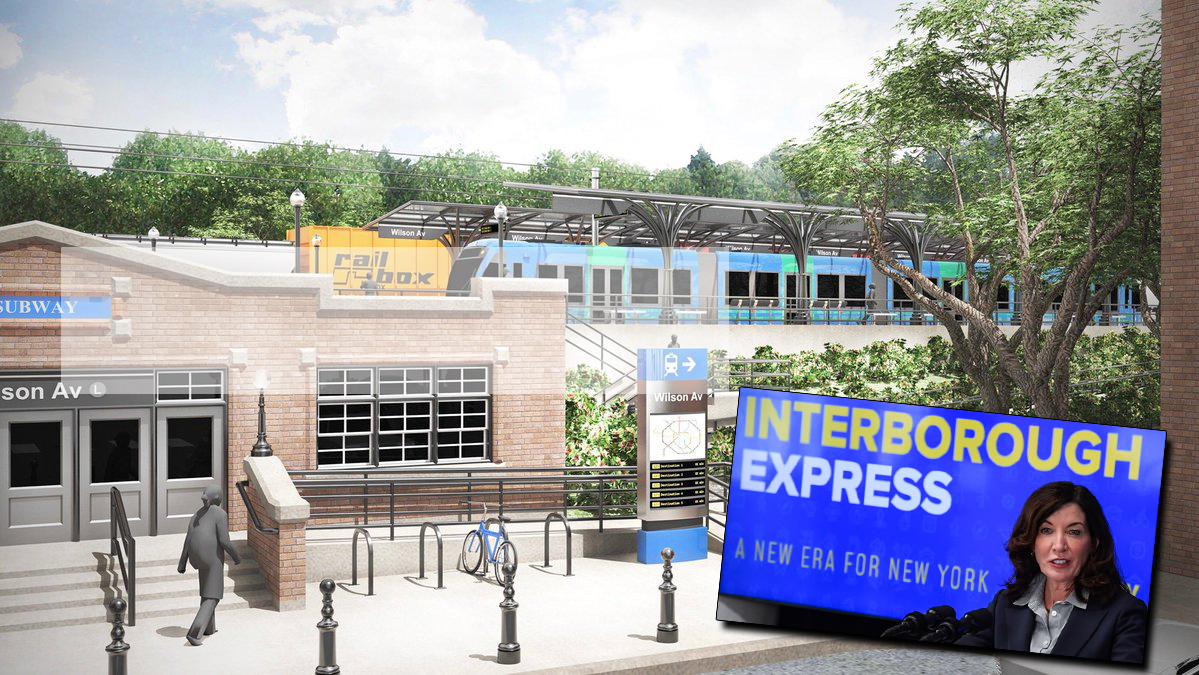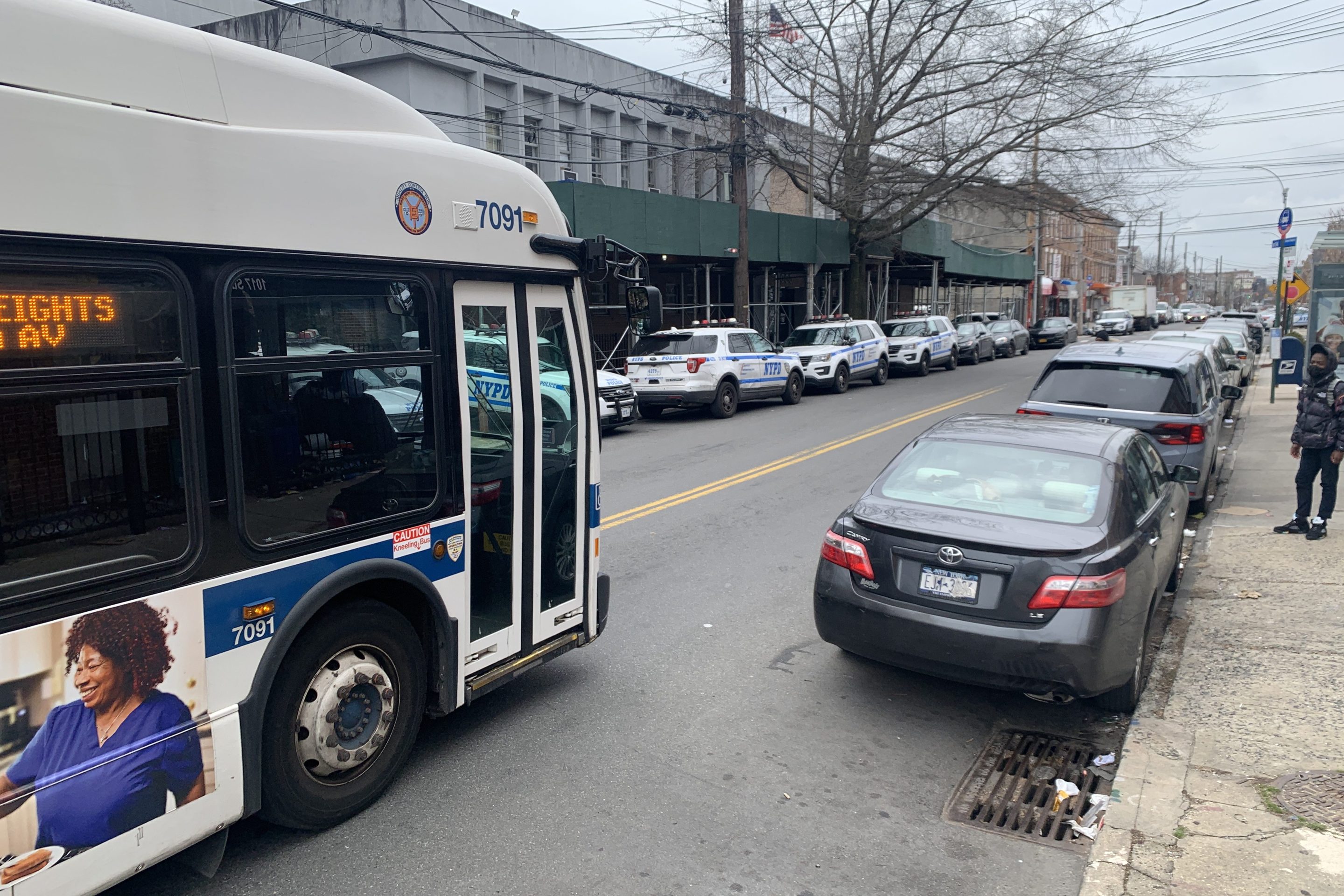It's full speed ahead on the Interborough Express, Gov. Hochul and the MTA's planned project to provide a new transit connection between Brooklyn to Queens. The transit project — which will use an existing right of way between Bay Ridge and Jackson Heights that runs through Flatbush, Brownsville, East New York and Maspeth, is currently only used by freight rail — is slated to be part of the MTA's 2025-2029 capital plan if the agency can complete an environmental review for it in time. As a transit expansion plan, the Interborough comes with a huge advantage with the rail trench that already exists, but the MTA will still need to figure out where to put stations, widen sections of the freight cut and lay down additional track.

When Gov. Hochul first announced the project, the MTA said it would first choose the mode among three options: Light rail, heavy rail (similar to commuter rail like on the Long Island Rail Road and Metro-North) or bus rapid transit. The MTA has answered one question about the future of the project by picking light rail, but don't worry, there are still plenty of questions the agency will have to answer about the how the Interborough will work.
Will it have a free transfer to the subway or bus?
Will it grind to a halt when the train runs on New York's car-choked streets for a short time?
Where will it go in the future?
Will it really cost $5.5 billion?
Let's find out.
Will there be a smooth transfer?
Gov. Hochul and the MTA have made sure to point out that the train will not only connect Brooklyn and Queens, but also connects to almost two dozen subway lines along its route. Of course, those connections wouldn't mean much if, like the commuter rail system, you couldn't actually connect to the subway or bus with a free transfer.
The recent environmental linkages study on the Interborough doesn't mention free transfers and the MTA Board ultimately has to set the fare, but the MTA is expecting that the cost of a ride on the Interborough will be the same as the bus and subway fare, and riders will have a seamless connection to the city's other mass transit with OMNY. Experts say that's how it should be, even if a light rail is not exactly the same as s subway.
"It doesn't matter what the mode is, it matters whether your MetroCard works or not," said Rachel Weinberger, the director of research strategy at Regional Plan Association. "System connectivity really is about transparent transfers and an integrated fare system. If I'm getting off one kind of vehicle and on to another kind of vehicle, as a rider that I'm not even that aware of that."
Station placement will also be important to make the transfer as easy as possible for future riders.
"I hope that the MTA has more public hearings, where they really focus on each of the new stations and stops and talk to people who are in the community and really get a sense of how to make those connections work really safely and really easily for the riders," said Felicia Park-Rogers, director of regional infrastructure projects at the Tri-State Transportation Campaign.
Can it survive Metropolitan Ave.?
The billion-dollar question for the Interborough Express will be whether it can effectively navigate a proposed on-street section in Queens.
At All Faiths Cemetery in Middle Village, Queens, the train will have to leave the right-of-way because the existing tunnel under the cemetery can only accommodate freight rail. One reason the MTA picked light rail as the preferred option for the Interborough is that it has the ability to leave the freight cut and run on the street, which third-rail-powered heavy rail can't do.
Per the existing conditions report on the IBX, the light rail will run on Metropolitan Avenue, 69th Street and 69th Place for about two-thirds of a mile. But the report then immediately notes that "operation in the street may affect streetscape conditions, which will be studied in future project phases."
Because the MTA would prefer to avoid spending a couple billion dollars on a new tunnel under the graveyard, the agency feels that the street engineering work is a better way to go for the project. Already, car supremacist forces are preparing to raise hell over the idea that any public transit might get in the way of their precious vehicles (though these forces are disingenuously raising the issue in the name of safety). But if safety is a problem for the future, observers also see it as one for the present.
Based on the MTA's IBX report, we drew a crude map of where they plan to run the light rail on the street. We are eager to hear more details, as this plan seems to require extensive property condemnation and will likely increase traffic and create safety issues in Middle Village. pic.twitter.com/cq9qNvo9jq
— Juniper Park Civic (@junipercivic) January 13, 2023
"I see it more as an opportunity to fix Metropolitan Avenue," said transit researcher Eric Goldwyn. "The engineering needs to be worked out, but it's not an impossible task by any means. One of the great missed opportunities of Phase 1 of the Second Avenue subway is that we didn’t reclaim any space on Second Avenue for pedestrians. When other cities add a new subway, they use it as an opportunity to build plazas and rethink the road network. IBX will definitely require that kind of thinking."
The traffic engineering on the streets will not only have to ensure that the light rail runs safely, but also can keep to its preferred schedule, which the MTA has set at five-minute headways during peak hours.
"There there are different ways that that different places have done it. Metropolitan Avenue is a very wide street, so one way that it's been done in Los Angeles and San Francisco is that there's a raised median, and the light rail actually runs down the middle of the street," said Park-Rogers.
"When people are getting off and on essentially there's a platform in the middle and then runs in either direction on either side of the platform. And then that way, you can have protected crosswalks coming off of the median, essentially a little platform for entry and exit. I think something like that would probably be ideal. If not, it should be just a protected corridor where it's trucks and light rail only."
Getting signal prioritization right, possibly with similar technology to transit signal priorities for buses, is also going to be critical to keep the IBX on schedule, since moving off of Metropolitan Avenue and onto 69th Street will require the light rail to make a dreaded left turn through traffic.
"You could do something more dynamic that's that requires the same kind of technology as the way that signal prioritization works," said Weinberger. "If is the signal has a sensor, it knows when the light rail vehicle is coming and so it can green light the light rail, so it's not stopped at a traffic light, it only has to stop its stops. A dynamic signal system, as opposed to just sort of a standard, X seconds of green, and then it's this many seconds of yellow and that many seconds of red and you just cycle through it."
Where does it go from here?
Just because the Interborough hasn't "been built" yet doesn't mean we can't already demand its expansion.
In fact, the MTA even noted that light rail "service could be expanded in the future [because] light rail avoids or minimizes environmental issues to a greater extent than the other alternatives." And the Interborough was born out of a proposal that would have been a tri-borough connection up to the Bronx instead of a bi-borough connection between Brooklyn and Queens, so can that happen in the future?
According to the MTA, an extension into the Bronx isn't in the cards mostly because of Penn Access — the project that will bring Metro-North trains from the Bronx to Penn Station through a part of Queens that's in the right-of-way north of the IBX's northern terminus at Roosevelt Avenue. The MTA also asserts that Penn Access will cause the Hell Gate Bridge to hit capacity once it's running Amtrak, freight and Metro-North trains all day, so an extension to the Bronx would require an entirely new bridge.
Queens residents have pushed to connect Penn Access to the World's Borough with a station in Astoria, and have also asked the MTA to get Sunnyside in the mix with a Long Island Rail Road or Metro-North stop in the neighborhood. The MTA has at least said that a Sunnyside station is being studied for possible inclusion in the next 20-Year Needs Assessment due in October this year, and IBX boosters say that once the light rail is running it could be time to see how to find a way to connect it to the Bronx even somewhat indirectly.
"Even from RPA's point of view, the Bronx portion was always going to be the the most complicated portion. And when we first started talking about 'The Triboro,' it predated Penn Access, so the connectivity to the Bronx, to some extent is satisfied there," said Weinberger. "But I think that the Bronx conversation becomes easier to have once these other parts are built rather than having to have the whole conversation all at once. Let's get two-thirds of the boroughs, and then let's think about the Bronx holistically in terms of the system, and whether it's an extension of this line, or whether there are other options to look at."
Will the price tag stick?
The Interborough is estimated to cost $5.5 billion, which the MTA's planning study says covers the physical construction and power and other systems needed to make the train move. The cost includes unforeseen contingencies, which experts said is a smart and necessary idea, since the project includes expanding the right of way and dealing with the many existing overpasses that cross the freight cut. According to the MTA, the project could involve reconstructing as many as 45 bridges that cross the cut along the route.
"It's always possible that something's going to cost more than they think right now because, oh, whoops that overpass will fall down so we have to totally rebuild it, or they can't get the right of way or the easement that they need," said Park-Rogers.
Weinberger agreed with that assessment, and mentioned an unexpected discovery that jacked up the price of a San Francisco light rail project.
"I was talking to San Francisco folks about their new light rail extension about a year or so ago, and while this is not going to be the case for this project because their project had some tunneling for new underground stations, they said they ran into under underground streams that they never anticipated. That kind of thing happens," she said.
The IBX compares favorably on a per-mile cost to some other North American light rail projects, coming in at $392 million-per-mile for the 14-mile project with an unknown number of stations. In comparison, Pittsburgh's North Shore Connector cost $560 million-per-mile for a light rail project with just three stops, and Seattle's U-Link light rail cost $511 million-per-mile for a project with three stops. Looking north to Canada, a 10-mile extension of Vancouver's elevated SkyTrain light rail will cost about $397 million-per-mile. The MTA has also highlighted the cost per rider of of $48,000 for the light rail project as the lowest of the three potential options it was studying.
The IBX is also an expansion project that fills a totally unfilled need to connect south Brooklyn to western Queens by public transit, giving people more options for intracity travel.
"I am disappointed that the MTA isn't going with heavy rail. But this is an exciting project that connects with the city's efforts on the BQE, because one of the things that we're talking about is really looking for ways to reduce the car usage on the BQE but it's very hard to get between Brooklyn and Queens by transit," said Park-Rogers. "And I'm really hopeful that this will help take some of the cars off with the highway," said Park-Rogers.
The connectivity of the Interborough, which is projected to attract 115,000 daily riders by 2045, gives it an added value as well.
"The real question is what the benefit is relative to that cost. Sometimes the projected immediate benefit discounts the more extensive network benefit from something like this, that's a very unique link in the system, right, because it ties together so many lines. So a mile of track here is not the same as a mile of track there. It's not just that traveller from Jackson Heights to Bay Ridge, but it's also all the additional connections that can be made. The more we build out the system in this way, the more obvious choice using the transit system becomes," said Weinberger.






